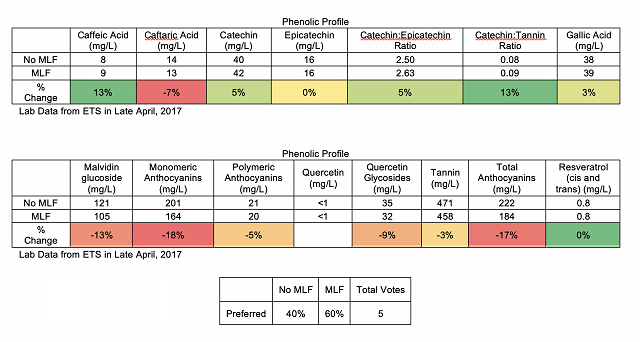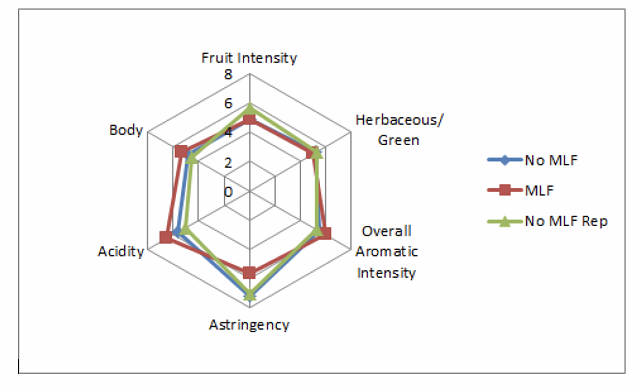The Stylistic Impact of Malolactic Conversion on Cabernet Sauvignon (2016)
Wendy and Donald Furrow-Scott
Hickory Hill Vineyards and Winery
Summary
This study examines the stylistic impact that malolactic conversion has on Cabernet Sauvignon. Two lots of Cabernet Sauvignon wine were pressed and combined into one tank. A portion of this wine was sequestered in carboy in order to not undergo malolactic conversion. The portion in the tank was inoculated with Lalvin Elios Malolactic Bacteria. The control wine was sulfured in order to prevent natural malolactic conversion from occurring. The results show classical malolactic conversion results, with a decrease in TA and malic acid and increase in pH, lactic acid, and VA. The slight decrease in anthocyanin and tannin is also typical of malolactic conversion. If the wine made with malolactic conversion had been sulfured, it would likely show lower color intensity as well. Sensory analysis found the wines to be significantly different (p<0.05). These wines were voted to have an average degree difference of 4.8 (out of 10), suggesting that the wines were moderately different. There was no major preference trend for the wines in this study. Comments on this study were mixed. There were no strong trends for the descriptors used in this study. In general, the wine with no malolactic conversion tended to show higher Astringency, lower Body, and (surprisingly) lower Acidity. The effect of malolactic conversion on the fruit aromatics, as well as on green and herbaceous qualities, seemed complex and merits further attention.
Introduction
Malolactic conversion is often performed on red wines to reduce the harsh acidity from malic acid, as well as to enhance the structure and flavor of the wines. Additionally, malolactic conversion also tends to enhance the microbial stability of the wine: but this effect can be mixed as it can often raise the pH to dangerously high levels. Malolactic conversion often results in lower titratable acidity, higher pH, higher volatile acidity, and lower tannin, anthocyanin, and color. As such, it can have a large stylistic impact on finished wine. Hickory Hill Winery generally produces Cabernet Sauvignon which does not undergo malolactic conversion, and the purpose of this study was to compare the stylistic impact of malolactic conversion on wine.
Results and Discussion
The results show classical malolactic conversion results, with a decrease in titratable acidity and malic acid and increase in pH, lactic acid, and volatile acidity. The slight decrease in anthocyanin and tannin is also typical of malolactic conversion. If the wine made with malolactic conversion had been sulfured, it would likely show lower color intensity as well. For the triangle test, of 7 people who answered, 5 people chose the correct wine (71%), showing a statistically significant difference between wines (p<0.05). These wines were voted to have an average degree difference of 4.8 (out of 10), suggesting that the wines were moderately different. There was no major preference trend for the wines in this study. Comments on this study were mixed. There were no strong trends for the descriptors used in this study. There were no strong trends for the descriptors used in this study. In general, the wine with no malolactic conversion tended to show higher Astringency, lower Body, and (surprisingly) lower Acidity. The effect of malolactic conversion on the fruit aromatics, as well as on green and herbaceous qualities (as discussed during the tasting), seemed complex and merits further attention.



Methods
Approximately 2.8 tons of Cabernet Sauvignon grapes from the same block was harvested on 9/24/2016 and 9/25 and refrigerated at 35°F. These lots were crushed together on 9/28, and split into 2 1000L stainless tanks. 50ppm sulfur dioxide was added at crush. Must was soaked from 9/28-9/30. Juice Chemistry was taken on 9/30, and then each tank was chaptalized up to 23 Brix and tartaric addition to bring pH down to 3.6. FT Rouge was added, and FX10 yeast was added to one tank and MT yeast was added to the other tank. Both tanks were punched down twice per day. On 10/7 the wine was pressed and combined into one tank (150 gallons). On 11/4 a five gallon carboy was set aside as a control, and 8g Lalvin Elios MLB was added to the test tank. On 12/11, 40ppm sulfur dioxide was added to the control. On 4/19/2017 the control was sulfured again at 40ppm and samples were taken for the WRE.
This study was tasted on May 17. For the triangle test and preference analysis, anybody who did not answer the form were removed from consideration for both triangle, degree of difference, and preference. Additionally, anybody who answered the triangle test incorrectly were removed from consideration for degree of difference and preference. Additionally, any data points for preference which did not make sense (such as a person ranking a wine and its replicate at most and least preferred, when they correctly guessed the odd wine) were removed.
In order to balance the data set to perform statistical analysis for descriptive, any judge who had not fully completed the descriptive analysis ratings were removed. In order to then make the number of judges between groups equivalent, one judge from group 2 was eliminated. This resulted in a final data set of 3 groups, each with 2 judges (considered as replications within groups, and groups were considered as assessors). Data was analyzed using Panel Check V1.4.2. Because this is not a truly statistical set-up, any results which are found to be statistically significant (p<0.05) will be denoted as a “strong trend” or a “strong tendency,” as opposed to general trends or tendencies. The statistical significance here will ignore any other significant effects or interactions which may confound the results (such as a statistically significant interaction of Judge x Wine confounding a significant result from Wine alone). The descriptors used in this study were Fruit Intensity, Herbaceous/Green, Overall Aromatic Intensity, Astringency, Acidity, and Body.
